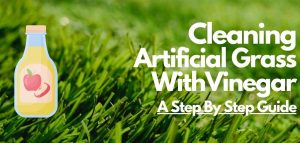Cleaning artificial grass with vinegar is a great way to keep your yard looking green and healthy.
It’s also the perfect solution for pet owners and allergy sufferers who can’t use harsh chemicals.
What is more, it will help stop that terrible dog odour in your yard!
Contents
- Advantages of Cleaning Artificial Grass with Vinegar
- How to Clean Artificial Grass With Vinegar
- 1) Dilute the Vinegar by Mixing it with Water
- 2) Apply Generously to the Artificial Grass
- 3) Rub in and Scrub with a Brush or Broom
- 4) Rinse off the area with clean water
- 5) Wait for the area to dry and then vacuum the area
- Precautions While Cleaning Fake Grass with Vinegar
- Conclusion:
Advantages of Cleaning Artificial Grass with Vinegar
- It’s inexpensive.
- It won’t damage artificial grass if you use the right amount of vinegar to water ratio.
- The smell is pleasant and dissipates quickly after rinsing with clean fresh water.
- It’s organic, so it won’t harm pets or wildlife that may come in contact with the artificial grass.
- It won’t leave behind any residue or film, so your artificial grass looks as good as new.
- Vinegar is environmentally friendly because it’s non-toxic and biodegradable.
How to Clean Artificial Grass With Vinegar
Here are the steps involved in cleaning artificial grass with vinegar.
1) Dilute the Vinegar by Mixing it with Water
Add one part of white distilled vinegar to two parts of hot or warm water.
If you want, you can add a few drops of dish soap; this will ensure that all dirt is removed from your artificial grass surface.
2) Apply Generously to the Artificial Grass
Dip a soft rag into the solution and squeeze out any excess liquid before wiping down the area.
You can also Pour or spray the vinegar/water mixture over the entire surface of the artificial lawn.
3) Rub in and Scrub with a Brush or Broom
Use the solution to clean your artificial grass by scrubbing gently.
Do not scrub too hard; doing so may damage your synthetic turf fibres. It’s okay if some stronger stains remain after cleaning; they’ll fade over time.
4) Rinse off the area with clean water
Rinse thoroughly with clean water and make sure all the dirt is removed. Repeat this process one or two times if necessary.
5) Wait for the area to dry and then vacuum the area
Vacuum the artificial grass to remove any dirt or pet hair that might have gotten stuck during cleaning.
Let dry completely before allowing pets back onto cleaned areas.
Precautions While Cleaning Fake Grass with Vinegar
Oils and Dirt: Remove the dirt and oils from the surface of the artificial grass before cleaning it with vinegar.
Fibres: Prepare a washing cloth by dipping it in water mixed with detergent. Rinse thoroughly before applying to the fibres of the artificial grass.
Water Supply: Ensure enough water supply to rinse out all of the vinegar after cleaning.
Vinegar: Ensure that the vinegar is not too strong or weak before adding it to water.
Conclusion:
If you need to clean your artificial grass, try using vinegar. It’s a natural cleaner that can get the job done without any harsh chemicals, and it won’t damage your fake grass like other cleaners might.
Vinegar is also inexpensive, which makes it an economical choice too! We know how important keeping up with lawn care tasks can be, so we hope this information will help make things easier for you in the future.
You can also apply a commercially available cleaner if you want. Make sure it is safe for use on fake turf before applying anything to your lawn, however. If you are unsure, try it out in an inconspicuous area first.
Now, tell us about your experience while cleaning synthetic turf with vinegar? Did it work well, or did you find yourself struggling?
Let us know what happened, and we can offer tips on how to avoid these issues next time around!
